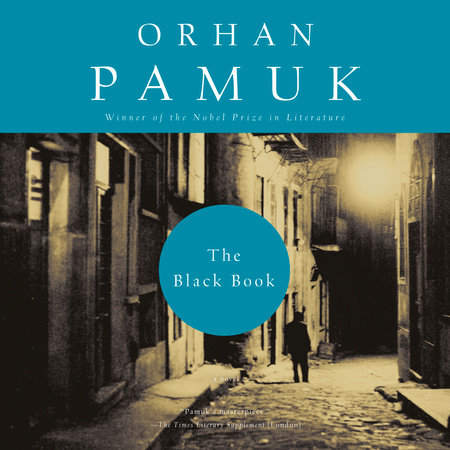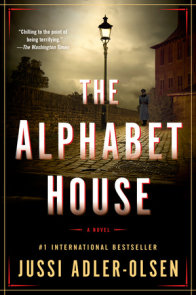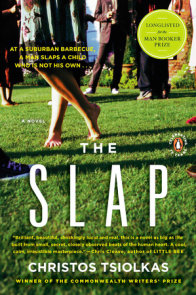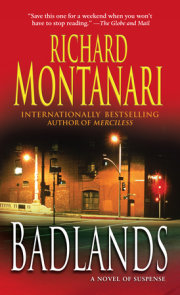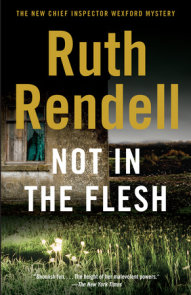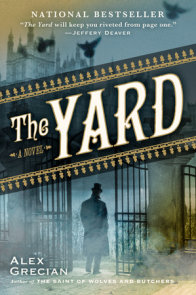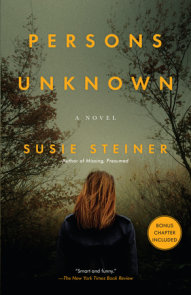READERS GUIDE
“An extraordinary, tantalizing novel.” —The Nation
The introduction, discussion questions, suggested reading, and author biography that follow are intended to enhance your group’s conversation about The Black Book, one of Orhan Pamuk’s most brilliant and intriguing novels, now in a new translation by Maureen Freely.
Introduction
In Istanbul, a lawyer called Galip comes home from work to find his beloved wife Rüya—who is also his first cousin—missing. She has taken no suitcases, and she has left a brief note that doesn’t say where she’s gone or why. Could she have left him for her ex-husband or Celâl, a popular newspaper columnist? Galip thinks Rüya must be with Celâl, because Celâl has disappeared too. Thus begins an extravagantly playful tale that is both a murder mystery and an absorbing journey through Istanbul’s fabled past and its troubled present. In its mind-bending exploration of identity and meaning, memory and love, The Black Book brings to mind the unforgettable urban odysseys of Joyce and Proust.Questions and Topics for Discussion
1.
The story opens as Galip muses about his wife’s dreams, then moves directly into a long sequence of memories of his childhood, which introduces the family and its history. The narrative does not move back to the present until page 12. Pamuk seems to suggest that both the past and the Celâl story are more important than Galip’s life in the present moment. How does the novel’s back-and-forth structure shape your reading experience and your sense of Galip’s character?
2.
Celâl never appears as a speaking character in the novel, yet his columns are crucial to understanding the mystery as well as the attraction of his character for Rüya, Galip, and many others. Why is Celâl’s writing so appealing?
3.
What is the significance of the underground mannequin museum described in chapter 6, “Bedii Usta’s Children” and visited by Galip in chapter 16? How is it related to the underworld depicted in Virgil’s Aeneid or Dante’s Inferno? Why was Bedii Usta’s dream that he’d one day see his mannequins in shop windows never fulfilled [p. 59–61]?
4.
In his column called “The Eye” [chapter 10], Celâl writes, “We all have a second person buried inside us, a dear friend to whom we whisper to our heart’s content, and some of us even have a third” and “The eye was the man I wished to be” [p. 117]. Is it true that we live with the presence of an ideal self—the person we wish to be—to whom we constantly compare ourselves? Is it also true that we involuntarily create this being in our own imaginations? If Celâl is the person Galip wants to be, who is the person Celâl wants to be?
5.
The whole family lived for a time in the City-of-Hearts Apartments, and when a new building went up next to theirs, an air shaft was created. This pit has powerful symbolic implications for Celâl and Galip; it is the place of lost objects, of memory, of the past [pp. 205–209]. How does Pamuk manage to make the pit resonate so profoundly with loss?
6.
As Maureen Freely notes in her afterword, the story “takes place at one of the darkest moments of recent Turkish history” [p. 463] and “a brutal coup that will end ‘the anarchy’ is nine months away” [p. 466]. How is the nation’s political situation expressed in The Black Book? What part does Celâl play in the politics of the novel’s historical moment?
7.
Like Proust’s Paris, Joyce’s Dublin, or Dickens’s London, Pamuk’s Istanbul is as much a state of mind as a geographical reality. How does Pamuk bring the city into the story, and what role does it play in Galip’s and Celâl’s mental worlds?
8.
One of Pamuk’s notable stylistic habits is his fondness for lists. See, for instance, the contents of Alâaddin’s shop [p. 41], the things that have fallen into “the dark air shaft” between the buildings [p. 207], the contents of Celâl’s desk [p. 95], or the anonymous caller’s list of what Celâl has written about police stations: “so many associations:—midnight blue, darkness, beatings, identity cards, the woes of being a citizen, rusting waterpipes, black shoes, starless nights, scowling faces, metaphysical inertia, misfortune, being a Turk, leaking faucets, and of course, death” [p. 349]. What is the effect of these lists, with their often fantastic juxtapositions, on the reading experience?
9.
Galip decides that “whatever meaning a person found in the world, he found by chance” [p. 26], yet his search through Celâl’s papers, photographs, and columns, and Celâl’s study of faces, ancient mystical texts, and so on, show he believes meaning is to be found through deliberate seeking. Which of these approaches seem to be correct? Does the novel’s opening epigraph from Ibn’ Arabi shed any light on this question?
10.
Rüya’s name means dream or fantasy; it’s also the name of the cinema in Beyoglu [p. 353]. How is the whole phenomenon of movie-going and movie star worship used in the story?
11.
Pamuk has a great deal of fun with other texts and authors, both real and imagined, throughout The Black Book. For instance, the thirteenth-century Sufi mystic and poet Celâlettin Rumi to whom the story refers many times has the same name as Celâl. One of the later poets who carried on the tradition of Rumi and the Divan school was Sheikh Galip, who is quoted in the epigraph to chapter 9 [p. 93] and elsewhere. What purpose do these historical figures serve in the story? What is the nature of Celâl’s interest in Islamic mysticism and his obsession with the relationship between Rumi and the Shams of Tabriz [chapter 22]?
12.
Reflecting on his marriage, Galip says, “Throughout the three years they spent together, it was Rüya . . . who’d seemed haunted by the life, the joys and pleasures that had slipped beyond her grasp” [p. 54]. Elsewhere he mentions “the bottomless well of Rüya’s indifference” [p. 458]. What kind of a person does Rüya seem to be? Why might she have married Galip? What motivates her to join Celâl in his return to “the garden of memory”?
13.
What is the “dreadful message” that Galip is finally able to read in his own face, and why does the realization of this “truth” cause him such sadness [pp. 323–24]?
14.
“Galip had once told Rüya that the only detective book he’d ever want to read would be the one in which not even the author knew the murderer’s identity” [p. 50]. Is The Black Book such a book? If “every detail in a detective novel served a purpose”—that purpose being to provide the clues about the villain—does The Black Book also provide everything we need to know to figure out who the killer is?
15.
The Black Book alludes not only to a number of eminent Western modernist works, but also to classics of Islamic literature such as the twelfth-century Persian masterpiece, Attar’s The Conference of the Birds, the late eighteenth-century Ottoman romance Beauty and Love by Sheikh Galip, and Celâlettin Rumi’s extravagant encyclopedic narrative Mathnawi. What do you think are Pamuk’s intentions in referring to the canon of Islamic literature?
16.
What is the relationship between memory and identity, and why is the fact that Celâl is losing his memory so important to what happens in the story? Celâl’s colleague Nesati says, “It’s not just his memory Celâl Bey has lost it’s his past—and this was his last link with his country. It’s no accident he can no longer write” [p. 322]. Does Pamuk’s work suggest that he would agree with this statement of Nesati?
17.
What challenges does the book present for the non-Turkish reader? How might The Black Book be transposed to an American city and an American cultural and historical context? Is there a novel you have read that does something similar with American culture, history, and identity?
18.
The Black Book plays with the familiar idea that sacred books, like the Koran or the Bible, contain mysteries that must be interpreted. In provoking the need for interpretation, the novel suggests, they are not unlike detective fiction, or maps of cities: all provide clues that will bring the diligent reader closer to a desired goal—the presence of God, the solution to a mystery, the end of a journey. How convincing is Pamuk’s parallel between religious stories and fictional ones? For whom might this parallel be considered blasphemous?
19.
Galip finds a poem that describes a “distant golden age” in which “action and meaning were one and the same. Heaven was on earth, and the things we kept in our houses were one with our dreams” [p. 301]. How does this “heaven,” in which every object, every word, means only itself, compare with the world in which Galip lives? What is ideal about having no distance between a sign and its significance, between stories and reality?
20.
Who is F. M. Üçüncü? The journalist Nesati says he was “a real-life person,” an army officer who was a reader of the paper, who then disappeared, and turned up again, “as bald as an egg,” “babbling about signs and omens” [p. 329]. Note also that the weapon used in the murder was a gun “of the sort issued to retired military personnel” [p. 446]. Is he the murderer?
21.
The Black Book is concerned with ideas of national identity and memory. Looking at the “ordinary” Turks in the mannequin museum, Galip realizes “Once upon a time, they had lived all together, and their lives had had meaning, but then, for some unknown reason, they had lost that meaning, just as they’d also lost their memories. . . . They felt the helpless pain known only by those who have lost their homes, their countries, their past, their history. . . . Their only hope was to stop trying to remember the secret . . . to hand themselves over to God, to wait in patient silence for the hour of eternity” [p. 194]. What are the forces that cause such a loss of memory and identity? How does a culture come to be unrecognizable to itself? Has American culture suffered a similar loss?
22.
By reading stories, The Black Book tells us, we get to inhabit the mind and life of someone else; yet we also prevent ourselves from being ourselves. Is it better to embellish one’s life with stories, or to attempt, as the Ottoman Prince in Galip’s story did [chapter 35], to eradicate them in order to be oneself? Do reading and writing doom us to live in a series of illusions, or is it in the end, as Galip concludes, “the only consolation” [p. 461]?
Orhan Pamuk Reader’s Companion
Orhan Pamuk was awarded the Nobel Prize for Literature in 2006, the first Turkish author to receive the award. He is the overall bestselling author in his homeland and his books have been published in more than fifty languages. This guide is designed to help you explore Pamuk’s world and writings, whether your group chooses to read all of his works or to focus on his acclaimed novels or engaging nonfiction titles.
Born in Istanbul in 1952, Pamuk grew up in a well-to-do, Western-oriented family. As a child he attended private schools and dreamed of becoming an artist. He began his studies at Istanbul Technical University in architecture, but at the age of twenty-two switched to journalism, taking the first step in his career as a writer. Pamuk’s first novel, Cevdet Bey and His Sons, the story of three generations of a Turkish family, was published in Turkey in 1982. The White Castle, the first of his novels to be translated into English, takes place in seventeenth-century Constantinople (as Istanbul was then called) and explores the meeting between East and West, a theme that recurs throughout Pamuk’s writing career. The White Castle also introduced a deeper, more personal interest, one that imbues in his works of fiction and nonfiction alike: the relationship between dreams and reality, memory and imagination.
In his early years as a writer, Pamuk spent five years in residence at Columbia University, where he now holds a position as a visiting professor. In the autobiographical profile he wrote for the Nobel Prize committee, Pamuk reflected on his time as a visiting scholar at Columbia and the influence that had on his evolution as a writer: “I was thirty-three years old . . . and asking myself hard questions about who I was, and about my history. . . . During my time in New York, my longing for Istanbul mixed with my fascination for the wonders of Ottoman, Persian, Arab, and Islamic culture” (copyright © The Nobel Foundation, 2006). For much of those five years, Pamuk devoted himself to writing The Black Book, a strikingly original novel that weaves multiple voices and beguiling stories about Istanbul, past and present, into a modern-day detective story.
In his next novel, The New Life, Pamuk once again transformed the conventions of mystery into an intellectual adventure, creating a world in which a mysterious book, a fleeting romance, and conspiracies real and imagined wreak havoc on a university student’s life and his sense of identity. Set in the sixteenth century, My Name Is Red revisits Turkey’s rich and complex Ottoman past in a fascinating tale about the impact of Western art and aesthetics on an Islamic society that stifled individual creativity and strictly prohibited the creation of representational paintings.
As Pamuk’s fame grew throughout the 1990s, journalists in Turkey and abroad looked to him for elucidation on the political situation in his homeland and its relations with the West. Troubled by the changes occurring in Turkey, Pamuk wrote Snow, his first overtly political novel. A thought-provoking, witty, and balanced portrait of the rise of political Islamism, Snow was widely read and discussed in Turkey and became an international bestseller. The Museum of Innocence, Pamuk’s newest work of fiction, examines the nature of romantic attachment and the mysterious allure of collecting as it traces a wealthy man’s lifetime obsession with the lower-class woman he had loved and abandoned as a young man.
Collected essays, articles, and autobiographical sketches
Now in his late fifties, Orhan Pamuk lives in Istanbul in the same apartment building he grew up in. His deep attachment to the city is beautifully captured in Istanbul: Memories and the City, a combination of childhood memoir and journey into Istanbul life through his own eyes and those of painters and writers (including European visitors like the German artist Antoine-Ignace Melling and the French writers Gérard de Nerval and Gustave Flaubert); enhanced with photographs, it illuminates the personal and artistic influences on his work. Other Colors showcases the range and depth of Pamuk’s interests. There are short, lyrical pieces about his personal life collected under the apt and intriguing title “Living and Worrying”; critical essays on literary figures such as Dostoevsky, Camus, Nabokov, Vargas Llosa, and Rushdie, along with assessments of several of his own novels; and commentaries on a wide variety of political and cultural matters. A captivating collection, Other Colors provides fresh insights into the mind and imagination of one of today’s most notable writers.
A political drama and the recognition of Pamuk’s contributions to literature
In an interview with a Swiss newspaper in February 2005, Pamuk denounced the Ottoman massacre of millions Armenians in 1915 and the slaughter of thirty thousand Kurds in Turkey during the 1990s. His comments caused a furor in Turkey: several newspapers launched campaigns against him and he was officially charged with the crime of “publicly denigrating Turkish identity.” Facing death threats, Pamuk moved abroad. He returned to face a trial and the possibility of three years of imprisonment; the charges were dropped on a technicality in January 2006. The incident reverberated internationally, highlighting the conflict between anti-European nationalism in Turkey and the government’s campaign to join the European Union. It exposed, as well, the simmering distrust of—and sometimes blatant hostility toward—Muslim populations in the United States and Europe.
In awarding Orhan Pamuk the Nobel Prize for Literature in 2006, the Swedish Academy said, “In the quest for the melancholic soul of his native city, [Pamuk] has discovered new symbols for the clash and interlacing of cultures.” Pamuk’s Nobel Prize acceptance speech, “My Father’s Suitcase” (Other Colors, pages 403–17), offers a more personal explanation of why he became a writer and what he hopes to accomplish:
It was only by writing books that I came to a fuller understanding of the problems of authenticity (as in My Name Is Red and The Black Book) and the problems of life on the periphery (as in Snow and Istanbul). For me, to be a writer is to acknowledge the secret wounds that we carry inside us. . . . My confidence comes from the belief that all human beings resemble one other, that others carry wounds like mine—that they will therefore understand. All true literature rises from this childish, hopeful certainty that all people resemble one another.
For discussion
1. Have Pamuk’s books changed your perceptions of Turkey? What insights do they offer into the country’s history and place in the world?
2. Have his books given you a deeper understanding of the Muslim world? Have they altered your opinion about the current situation in the Middle East and other parts of the world where Islam is the dominant religion? Have you become more or less sympathetic?
3. Pamuk’s novels range over a wide span of time, from the sixteenth century (My Name Is Red) to the present day (Snow). Compare your reactions to the historical novels and the contemporary works. Which do you prefer and why?
4. In these books what impact do the tensions between Eastern and Western beliefs and customs have on individual lives, on the relations between classes and ethnic groups, or on political debates? What competing ideologies (or ways of thinking) affect the characters’ behavior and emotional responses? Consider the ethical, religious, and social dilemmas individuals face and how they resolve them.
5. Snow is prefaced by epigraphs from Robert Browning, Stendahl, Dostoevsky, and Joseph Conrad. How does each of them apply not only to Snow, but also to the other Pamuk books you have read? Citing specific passages, how would you characterize the author’s feelings about Western attitudes toward the Muslim world?
6. What role do perceptions—or misperceptions—about Islamic law and religious customs play in the assumptions Westerners make about Muslims? Are there current controversies in the United States or Europe that support your view?
7. Do Pamuk’s depictions of the relationships between men and women conform to your impressions of romance, marriage, and family life in a Muslim society? How are women presented in the historical novels? In what ways do the women in the novels set in the present (or in the recent past) embody both traditional female roles and the new opportunities they have to express their opinions and act on their beliefs?
8. Istanbul opens with an essay about Pamuk’s feelings as a child that “somewhere in the streets of Istanbul . . . there lived another Orhan so much like me that he could pass for my own twin, even my double” (page 3). Many reviewers, including John Updike, Christopher Lehmann-Haupt, and Charles McGrath, have written about what McGrath calls “an enduring Pamuk preoccupation: the idea of doubleness or split identity” (New York Times, October 13, 2006). Can you find examples of doubleness in the books you have read, and if so, what do these add to the story? What insights do they reveal about Pamuk’s own sense of identity?
9. What techniques does Pamuk use to bring his characters, real and fictional, to life? How do his descriptions of settings, manners, and other everyday details enhance the portraits he creates? What use does he make of humor, exaggeration, and other stylistic flourishes in his depictions of particular situations, conversations, musings, and arguments?
10. Pamuk employs many of the literary devices associated with postmodern and experimental fiction. (McGrath, for example, notes his use of “narratives within narratives, texts that come alive, labyrinths of signs and symbols . . .”). In what ways do his books echo Italo Calvino’s allegorical fantasies? What do they share with the writings of Jorge Luis Borges and other magical realists? What aspects of his literary style can be traced to earlier masters of innovative fiction like Kafka and Nabokov?
11. In an essay on the Peruvian writer Mario Vargas Llosa in Other Colors, Pamuk writes, “It is clear . . . that there is a sort of narrative novel that is particular to the countries of the Third World. Its originality has less to do with the writer’s location than with the fact that he knows he is writing far from the world’s literary centers and he feels this distance inside himself” (page 168). Discuss how this manifests itself in Pamuk’s own works, as well as the works of Vargas Llosa and other authors writing from the Third World. Are there creative advantages to living and writing “far from the world’s literary centers”?
12. Pamuk writes in Istanbul of authors who left their homelands—Conrad, Nabokov, Naipaul: “Their imaginations were fed by exile, a nourishment drawn not through roots, but through rootlessness” (page 6). If you have read the works of these writers, or other authors in exile, do you agree that their books reflect—in style or in content—the effects of living in a new, foreign culture? To what extent is Pamuk’s writing rooted in the storytelling traditions of Eastern cultures? In what ways does it show the influence of his early exposure to Western literature, his participation in international literary circles, and his longtime association with American academia?
13. Despite the many differences between the societies Pamuk describes and our own, why do his characters and their behavior resonant with contemporary English-speaking readers? Are there aspects of Turkish mores that make it difficult to sympathize or engage with the characters in the novels? Do these factors also influence your reactions to his autobiographical pieces, literary criticism, and cultural observations in both Other Colors and Istanbul?
14. How does Pamuk’s personal history, as well as the plots of some novels, mirror the complicated history of Turkey? Consider such topics as: the decline and dissolution of the once powerful Ottoman Empire; the sweeping changes initiated by Atatürk in the 1920s; the conflicting desires to preserve Turkey’s distinctive heritage and to become more active in the global community; and the rise of fundamentalist Islam throughout Middle East today.
15. In discussing the importance of novels, Pamuk says, “Modern societies, tribes, and nations do their deepest thinking about themselves by reading novels; through reading novels, they are able to argue about who they are” (Other Colors, page 233). Do you agree? What can novels provide that nonfiction books and other media do not?
Suggestions for further reading
Paul Auster, The New York Trilogy; Jorge Luis Borges, Collected Fictions; Italo Calvino, Invisible Cities; Kiran Desai, The Inheritance of Loss; Fyodor Dostoevsky, Notes from Underground; Umberto Eco, Foucault’s Pendulum; Franz Kafka, The Castle; James Joyce, A Portrait of the Artist as a Young Man; Milan Kundera, Immortality; Naguib Mahfouz, The Cairo Trilogy; Gabriel García Marquez, Love in the Time of Cholera; Vladimir Nabokov, Ada; V. S. Naipaul, A Bend in the River; Marcel Proust, Remembrance of Things Past
Pamuk’s works are available in Vintage paperback editions (listed here in order of their first translation into English): The White Castle; The New Life; My Name Is Red; The Black Book; Snow; Istanbul; Other Colors; The Museum of Innocence
(For a complete list of available reading group guides, and to sign up for the Reading Group Center enewsletter, visit www.readinggroupcenter.com)









